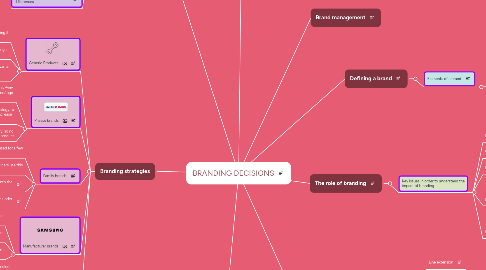
1. Defining a brand
1.1. Elements of a brand
1.1.1. people, businesses, countries, cities can also be branded
2. The role of branding
2.1. Key issues in order to understand the impact of branding
2.1.1. Benefits of branding
2.1.2. Characteristics of a brand name
2.1.3. Brand loyalty
2.1.3.1. 3 levels: Brand recognition, Brand preference & Brand insistence.
2.1.4. Building brand equity
2.1.4.1. Brand value
2.1.4.2. Brand awareness
2.1.4.2.1. Brand recall
2.1.4.2.2. Brand recognition
2.1.5. Brand protection
2.1.5.1. Brand piracy
3. Brand components
3.1. What is a trademark?
3.1.1. A brand name, slogan, specific shape or logo that identifies and distinguishes the products or services of another company/service provider
3.1.2. Registering a trademark grants the owner exclusive rights to use the mark.
3.1.3. Protected foerver, as long as renewed every 10 years with a renewal fee
3.2. What is copyright?
3.2.1. Granted for a specific term & extends to 50 years after the death of creator, thereafter, work is free for the public
3.2.2. Protects certain classes/categories of work
3.3. Branding assessments
3.4. Brand names & Brand marks
3.4.1. Brand name - one/more words, combo of letters, combo of numbers, which will form a unique name that represents the company's offerings to the market
3.4.2. Brand mark - any picture, logo, symbol/shape that differentiates a product
3.5. International branding & cultural differences
4. Branding strategies
4.1. Generic Products
4.1.1. carry a basic label with no branding & cheaper than branded
4.1.1.1. low cost on promotion or advertising
4.1.2. selling your products without investing in branding.
4.1.3. used during economic downfalls or wants to offer a cheaper alternative to a well-known brand
4.2. Private brands
4.2.1. The distributor buys products in bulk from manufacturer & puts their own name/logo on the product
4.2.1.1. allows retailers to offer their own brands without having to be involved in the manufacturing process
4.2.2. manufacturers are able to use strategy to reach more market segments & increase turnover
4.2.3. consumer knows attributes already, so no need to educate consumer about product
4.3. Family brands
4.3.1. common brand name used for a few related products
4.3.1.1. AKA - umbrella brands
4.3.2. manufacturing & service providers use this strategy
4.3.3. customer trust & loyalty is built into the family brand name
4.3.4. promotion is focused on all products under brand name
4.4. Manufacturer brands
4.4.1. produced and promoted by the manufacturer
4.4.2. develops the product & create an image for the brand
4.4.3. invest a lot of money, time and effort creating & promoting brand name
4.5. Individual brands
4.5.1. promoted independently (not bundled under a company name/family brand)
4.5.2. requires a unique approach for market segment
4.5.3. so unique, may not be able to identify the parent company that manufactures the brand
5. Brand management
6. Brand extensions
6.1. Types of extensions
6.1.1. Line extension
6.1.2. Range extension
6.1.3. Brand extension
